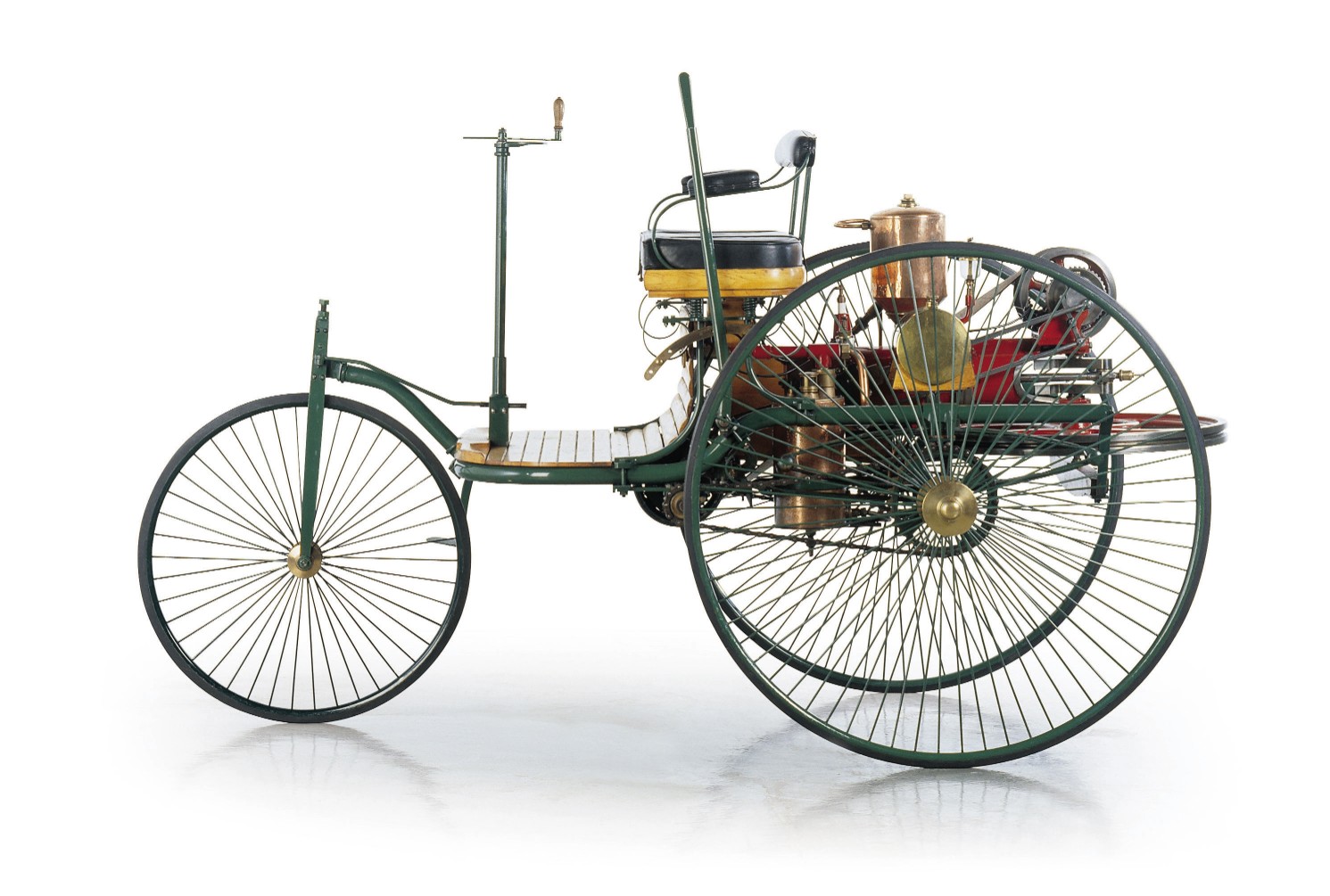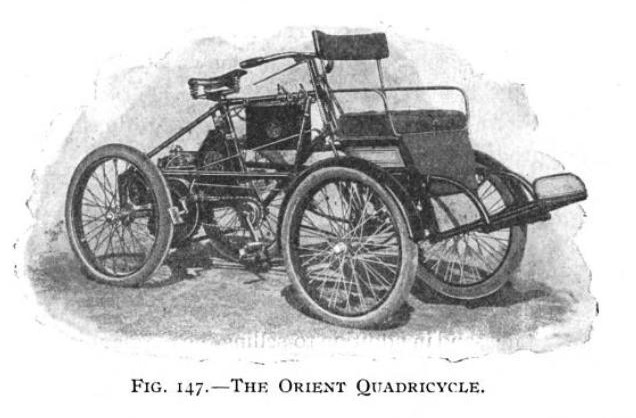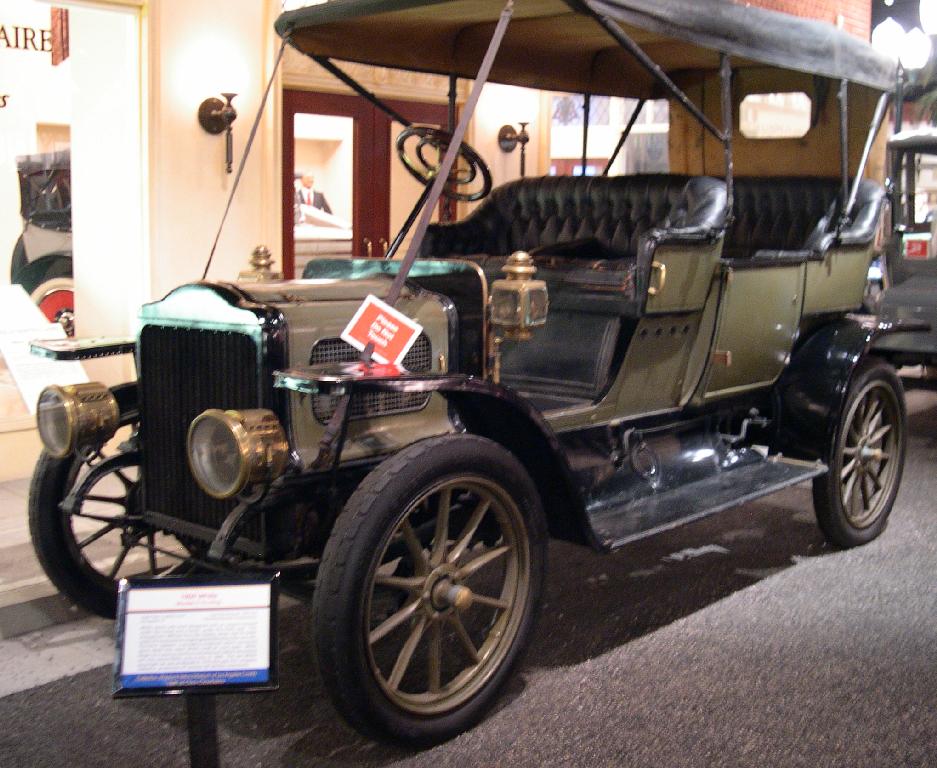|
Horseless Carriage
Horseless carriage is an early name for the motor car or automobile. Prior to the invention of the motor car, carriages were usually pulled by animals, typically horses. The term can be compared to other transitional terms, such as wireless phone. These are cases in which a new technology is compared to an older one by describing what the new one does not have. Most horseless carriages are notable for their similarity to existing horse-drawn carriages, but with some type of mechanical propulsion. Features of the first horseless carriages include tiller steering, an engine under the floorboards, and a high center of gravity. In the 19th century, steam engines became the primary source of power for railway locomotives and ships, and for powering processes in fixed installations such as factories. In 1803, what is said to have been the first horseless carriage was a steam-driven vehicle demonstrated in London, England, by Richard Trevithick. In the 1820s, Goldsworthy Gurney built ... [...More Info...] [...Related Items...] OR: [Wikipedia] [Google] [Baidu] |
Springfield, Massachusetts
Springfield is a city in the Commonwealth of Massachusetts, United States, and the seat of Hampden County. Springfield sits on the eastern bank of the Connecticut River near its confluence with three rivers: the western Westfield River, the eastern Chicopee River, and the eastern Mill River. At the 2020 census, the city's population was 155,929, making it the third-largest city in Massachusetts, the fourth-most populous city in New England after Boston, Worcester, and Providence, and the 12th-most populous in the Northeastern United States. Metropolitan Springfield, as one of two metropolitan areas in Massachusetts (the other being Greater Boston), had a population of 699,162 in 2020. Springfield was founded in 1636, the first Springfield in the New World. In the late 1700s, during the American Revolution, Springfield was designated by George Washington as the site of the Springfield Armory because of its central location. Subsequently it was the site of Shays' R ... [...More Info...] [...Related Items...] OR: [Wikipedia] [Google] [Baidu] |
Daimler Motorized Carriage
The Daimler Motorized Carriage was the first car produced by German engineers Gottlieb Daimler and Wilhelm Maybach, who founded Daimler Motoren Gesellschaft (DMG). The first car was sold in 1892. From 20 July 1872, Maybach and Daimler often worked as engineers in other companies at the same time, designing engines and accessories to engines for these companies. Finally, they worked together on the staff of the engine manufacturer, the Deutz-AG-Gasmotorenfabrik in Cologne that was half-owned by Nicolaus August Otto. In 1880 Daimler was fired by Otto and Maybach soon quit, whereupon, they began working as partners. Unknown to Otto, Daimler, and Maybach, during 1878 Karl Benz, in Mannheim, was concentrating all his efforts on creating a reliable two-stroke gas engine. Benz finished his engine on 31 December 1879, New Year's Eve, and was granted a patent for his engine in 28 June 1880 and along with the design and sale of static engines, he began to design a vehicle that could be mo ... [...More Info...] [...Related Items...] OR: [Wikipedia] [Google] [Baidu] |
Duryea Motor Wagon
The Duryea Motor Wagon was among the first standardized automobiles and among the first powered by gasoline. Fifteen examples were built by the Duryea Motor Wagon Company of Chicopee, Massachusetts, between 1893 and 1896. Their enterprise followed the first commercially available automobile which was patented by Karl Benz on January 29, 1886, and put into production in 1888. To construct the first Duryea Motor Wagon, the brothers had purchased a used horse-drawn buggy for $70 and then installed a , single cylinder gasoline engine. The car had a friction transmission, spray carburetor, and low tension ignition. It was road-tested again on 10 November, when the newspaper '' The Springfield Republican'' made the announcement. The car was put into storage in 1894 and stayed there until 1920 when it was rescued by Inglis M. Uppercu and presented to the United States National Museum. The Duryea Motor Wagon remained in production until 1917. The Duryea brothers entered their horsele ... [...More Info...] [...Related Items...] OR: [Wikipedia] [Google] [Baidu] |
Benz Patent-Motorwagen
The Benz Patent-Motorwagen ("patent motorcar"), built in 1885 by the German Carl Benz, is widely regarded as the world's first practical modern automobile and was the first car put into series production. It was patented and unveiled in 1886. The original cost of the vehicle in 1886 was 600 imperial German marks, approximately 150 US dollars (). Karl's wife Bertha demonstrated its feasibility in a trip from Mannheim to Pforzheim in August 1888, shortly before it became the first commercially available automobile in history in the late summer of 1888. Due to the creation of the Patent-Motorwagen, Benz has been hailed as the father and inventor of the automobile. Development and specifications After developing a successful gasoline-powered two-stroke piston engine in 1873, Benz focused on developing a motorized vehicle while maintaining a career as a designer and manufacturer of stationary engines and their associated parts. The Benz Patent-Motorwagen was a motor tricycle w ... [...More Info...] [...Related Items...] OR: [Wikipedia] [Google] [Baidu] |
Stagecoach
A stagecoach is a four-wheeled public transport coach used to carry paying passengers and light packages on journeys long enough to need a change of horses. It is strongly sprung and generally drawn by four horses although some versions are drawn by six horses. Commonly used before steam-powered rail transport was available, a stagecoach made long scheduled trips using ''stage stations'' or posts where the stagecoach's horses would be replaced by fresh horses. The business of running stagecoaches or the act of journeying in them was known as staging. Some familiar images of the stagecoach are that of a Royal Mail coach passing through a turnpike gate, a Dickensian passenger coach covered in snow pulling up at a coaching inn, a highwayman demanding a coach to "stand and deliver" and a Wells Fargo stagecoach arriving at or leaving a Wild West town. The yard of ale drinking glass is associated by legend with stagecoach drivers, though it was mainly used for drinking feats ... [...More Info...] [...Related Items...] OR: [Wikipedia] [Google] [Baidu] |
Brass Era Car
The Brass Era is an American term for the early period of automotive manufacturing, named for the prominent brass fittings used during this time for such things as lights and radiators. It is generally considered to encompass 1896 through 1915, a time when these vehicles were often referred to as horseless carriages. Elsewhere in the world, this period would be considered by antique car enthusiasts to consist of the veteran (pre-1904), and Edwardian eras, although these terms are really not meaningful outside the former British Empire. Overview Within the 20 years that make up this era, the various experimental designs and alternative power systems would be marginalised. Although the modern touring car had been invented earlier, until Panhard et Levassor's ''Système Panhard'' was widely licensed and adopted, recognisable and standardised automobiles had not been created. This system specified front-engined, rear-wheel drive, internal-combustion engined cars with a slidi ... [...More Info...] [...Related Items...] OR: [Wikipedia] [Google] [Baidu] |
Quadricycle
Quadricycle refers to vehicles with four wheels. In 1896 Henry Ford named his first vehicle design the "Quadricycle". it ran on four bicycle wheels, with an engine driving the back wheels.Brinkley, David, ''Wheels for the World: Henry Ford, His Company, and a Century of Progress'', (New York: Penguin Group, 2003), p.22 In 21st century France, a quadricycle is a 4-wheel car that cannot go faster than , weighs less than , and has a maximum power of . In the United States, a similar classification is the low-speed vehicle class. * Ford Quadricycle, Henry Ford's first design * Burnard Jarstfer Quadricycle (replica based on Ford Quadricycle) * Orient Quadricycle (aka Orient Autogo) * Truffault Quadricycle * Le Rudge Quadricycle Tandem * De Dion Bouton 1900 Quadricycle * De Dion Bouton Victoria Quadricycle [...More Info...] [...Related Items...] OR: [Wikipedia] [Google] [Baidu] |
Motorcycle
A motorcycle (motorbike, bike, or trike (if three-wheeled)) is a two or three-wheeled motor vehicle steered by a handlebar. Motorcycle design varies greatly to suit a range of different purposes: long-distance travel, commuting, cruising, sport (including racing), and off-road riding. Motorcycling is riding a motorcycle and being involved in other related social activity such as joining a motorcycle club and attending motorcycle rallies. The 1885 Daimler Reitwagen made by Gottlieb Daimler and Wilhelm Maybach in Germany was the first internal combustion, petroleum-fueled motorcycle. In 1894, Hildebrand & Wolfmüller became the first series production motorcycle. Globally, motorcycles are comparably popular to cars as a method of transport. In 2021, approximately 58.6 million new motorcycles were sold around the world, fewer than the 66.7 million cars sold over the same period. In 2014, the three top motorcycle producers globally by volume were Honda (28%), Yamaha (1 ... [...More Info...] [...Related Items...] OR: [Wikipedia] [Google] [Baidu] |
Electric Car
An electric car, battery electric car, or all-electric car is an automobile that is propelled by one or more electric motors, using only energy stored in batteries. Compared to internal combustion engine (ICE) vehicles, electric cars are quieter, have no exhaust emissions, and lower emissions overall. In the United States and the European Union, as of 2020, the total cost of ownership of recent electric vehicles is cheaper than that of equivalent ICE cars, due to lower fueling and maintenance costs. Charging an electric car can be done at a variety of charging stations; these charging stations can be installed in both houses and public areas. Worldwide, 6.6 million plug-in electric cars were sold in 2021, more than doubling 2020 sales, and achieving a market share of 9% of the global new car market. All-electric cars represented 71% of plug-in car sales in 2021. , 16 million plug-in electric cars were on the world's roads. Many countries have established government i ... [...More Info...] [...Related Items...] OR: [Wikipedia] [Google] [Baidu] |
Steam Car
A steam car is a car (automobile) propelled by a steam engine. A steam engine is an external combustion engine (ECE) in which the fuel is combusted outside of the engine, unlike an internal combustion engine (ICE) in which fuel is combusted inside the engine. ECEs have a lower thermal efficiency, but carbon monoxide production is more readily regulated. Steam-powered automobiles were popular with early buyers. Steam was safe, reliable, and familiar. People had decades of experience with it in trains and boats, and even in experimental road vehicles. However, early steam cars required constant care and attention—and up to 30 minutes to start. Automated quick-firing boilers solved these problems, but not before more efficient gasoline engines dominated the market and made steam cars obsolete. The first experimental steam-powered cars were built in the 18th and 19th centuries, but it was not until after Richard Trevithick had developed the use of high-pressure steam around 1800 ... [...More Info...] [...Related Items...] OR: [Wikipedia] [Google] [Baidu] |
Wagon
A wagon or waggon is a heavy four-wheeled vehicle pulled by draught animals or on occasion by humans, used for transporting goods, commodities, agricultural materials, supplies and sometimes people. Wagons are immediately distinguished from carts (which have two wheels) and from lighter four-wheeled vehicles primarily for carrying people, such as carriages. Animals such as horses, mules, or oxen usually pull wagons. One animal or several, often in pairs or teams may pull wagons. However, there are examples of human-propelled wagons, such as mining corfs. A wagon was formerly called a wain and one who builds or repairs wagons is a wainwright. More specifically, a wain is a type of horse- or oxen-drawn, load-carrying vehicle, used for agricultural purposes rather than transporting people. A wagon or cart, usually four-wheeled; for example, a haywain, normally has four wheels, but the term has now acquired slightly poetical connotations, so is not always used with technical ... [...More Info...] [...Related Items...] OR: [Wikipedia] [Google] [Baidu] |



.jpg)





